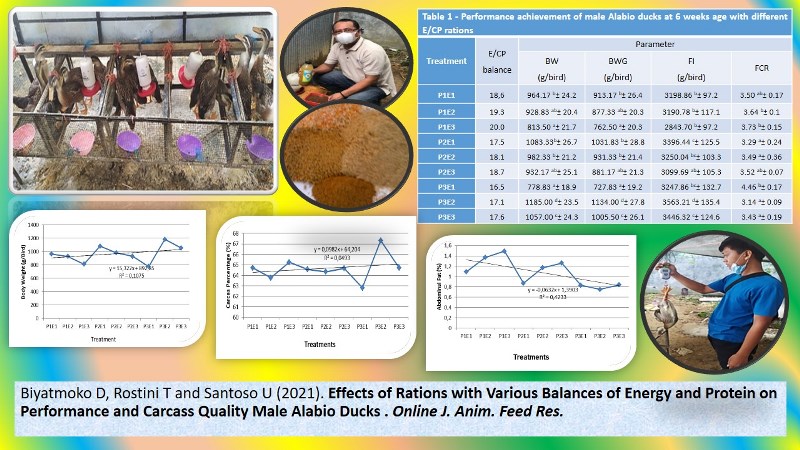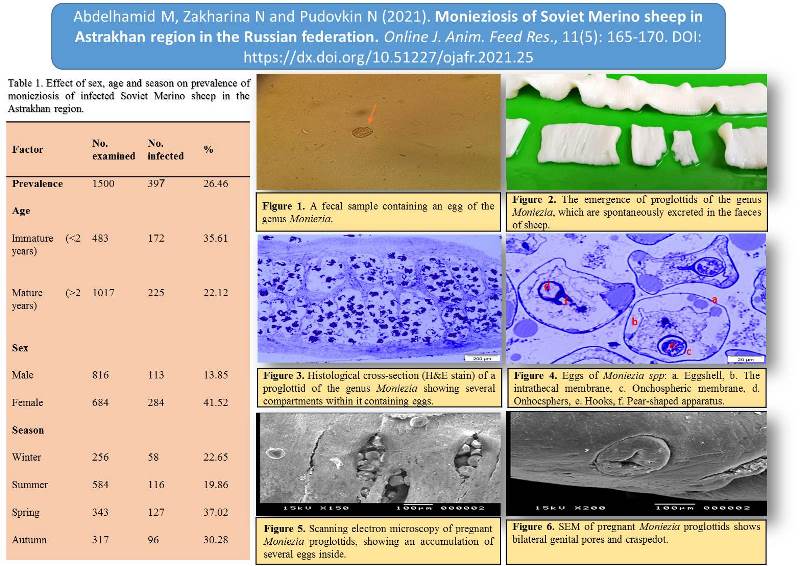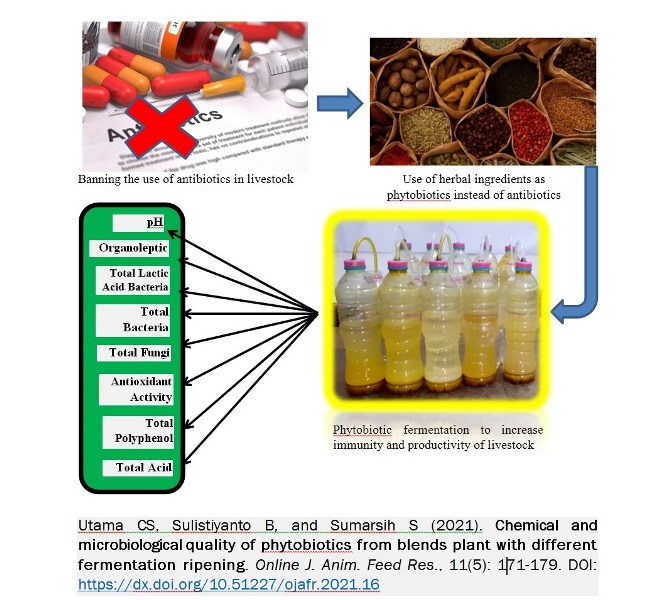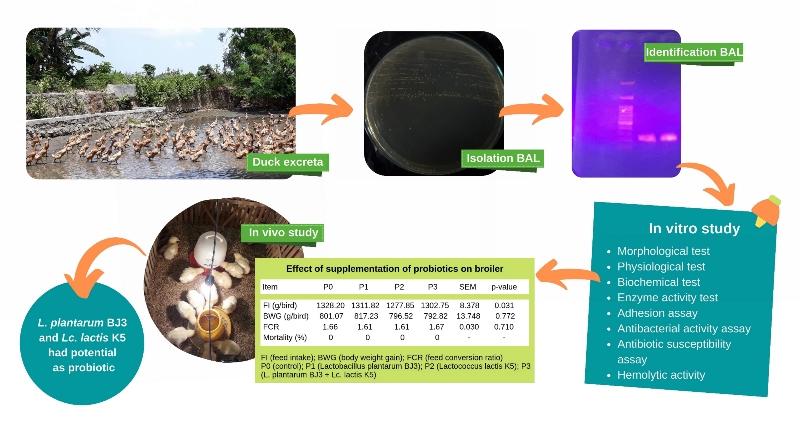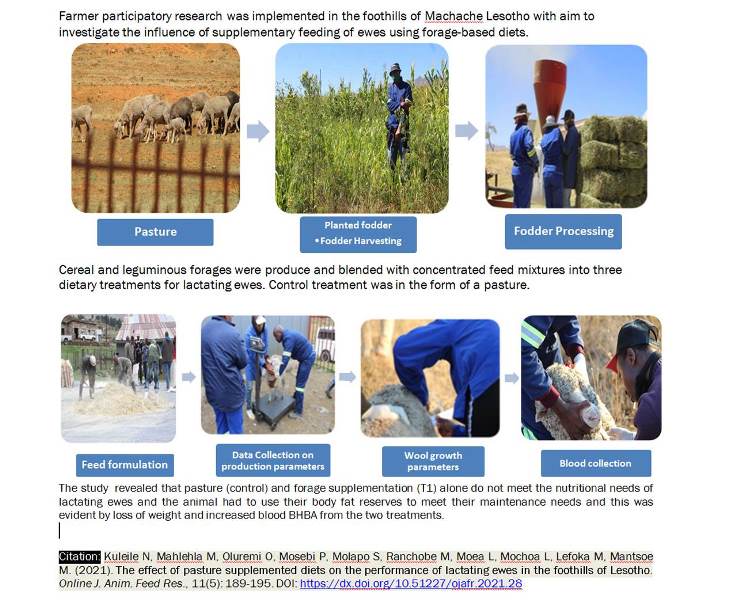Previous issue | Next issue | Archive
![]() Volume 11 (5); September 27, 2021 [Booklet] [EndNote XML for Agris]
Volume 11 (5); September 27, 2021 [Booklet] [EndNote XML for Agris]
Effects of rations with various balances of energy and protein on performance and carcass quality of male Alabio ducks
Biyatmoko D, Rostini T, and Santoso U.
Online J. Anim. Feed Res., 11(5): 157-164, 2021; pii: S222877012100024-11
DOI: https://dx.doi.org/10.51227/ojafr.2021.24
Abstract
For suitable nutrition according to the requirements of Alabio male ducks, it is necessary to balance metabolic energy and protein. The purpose of the study was to analyze the effect of the energy and protein balance (E/CP) on the growth achievement and carcass quality of Alabio male duck. The feeding trial study was conducted in a poultry house for six weeks. The research method used a completely randomized design (CRD) with factorial pattern where is the first factor being metabolic energy+y level (E) consisting of E1: 2800 kcal/kg ME, E2: 2900 kcal/kg ME, E3: 3000 kcal/kg ME, while the second factor was crude protein level (CP) consisting of P1: 15% CP, P2: 16% CP, P3: 17% CP, with three replications, where each replication consisted of five ducks with a total of 135 male Alabio ducks. The observed variables were final body weight (BW), body weight gain (BWG), feed intake (FI), feed conversion ratio (FCR), carcass percentage, carcass fat, and abdominal fat. The data obtained have been analyzed by analysis of variance (ANOVA) method. The results showed that there was an interaction between (E) and (CP), where the best results were obtained in the combination of E2P3 treatment with an E/CP ratio of 17.1 (ME 2900 kcal/kg, 17% CP), including BW at 1185.0 g/bird, BWG at 1134.0 g/bird, FI at 3563.21 g/bird, and FCR at 3.14 and the lowest carcass quality with the highest carcass percentage reaching 67.33%, and the lowest carcass fat and abdominal fat were 0.37% and 0.75%, respectively. It was concluded that the effect of E/P ration at ratio of 17.1 gives the best result on the performance of male Alabio ducks including the achievement of BW, BWG, FI and FCR, and carcass quality through the achievement of increasing carcass percentage, decreasing carcass fat and fat abdominals.
Keywords: Alabio duck, Carcass Quality, Crude protein, Performance, Ration.
[Full text-PDF] [Scopus ID: 85118788241] [ePub] [Export from ePrint] [Export citation to RIS & EndNote] [How to Cite]
Monieziosis of Soviet Merino sheep in Astrakhan region in the Russian federation
Abdelhamid M, Zakharina N and Pudovkin N.
Online J. Anim. Feed Res., 11(5): 165-170, 2021; pii: S222877012100025-11
DOI: https://dx.doi.org/10.51227/ojafr.2021.25
Abstract
In present study, the prevalence of monieziosis infections was determined in Soviet Merino sheep and risk factors associated therewith was identified in the Astrakhan, a region of traditional development of sheep farming located in the south of the European part of Russia. One thousand five hundred Soviet Merino sheep, different in age and sex, from different districts in the Astrakhan region, were examined using the Fülleborn's technique for detection of eggs of genus Moniezia in fecal samples. Histological sections of gravid proglottids were stained for histological and Scanning Electron Microscopy (SEM) examination. It was found that monieziosis was recorded (26.46 %) among the examined sheep. Moniezisois was found more prevalent in grazing female (41.52 %) and young sheep (35.61 %). The highest incidence of monieziosis in Soviet Merino sheep was found in spring (37.02 %). By histological and SEM examination, the gravid proglottids of genus Moniezia, showing several compartments inside it containing several eggs and the proglottids containing bilateral genital pores and craspedote.
Keywords: Astrakhan, Cestode, Fecal examination, Merino sheep, Monieziosis.
[Full text-PDF] [Scopus ID: 85119194757] [ePub] [Export from ePrint] [XML] [Export citation to RIS & EndNote] [How to Cite]
Chemical and microbiological quality of phytobiotics from blends plant with different fermentation ripening
Utama CS, Sulistiyanto B, and Sumarsih S.
Online J. Anim. Feed Res., 11(5): 171-179, 2021; pii: S222877012100026-11
DOI: https://dx.doi.org/10.51227/ojafr.2021.26
Abstract
Alternative antibiotic replacements that are often used, namely probiotics, prebiotics, phytobiotics and acidifiers, have the same function and role as antibiotics. Phytobiotics are active ingredients that have antibacterial properties derived from herbal ingredients which newly used in human and animal nutrition, and this is new approach of nutritional studies. Fermentation process can improve the quality of phytobiotics. The purpose of the study was to examine the effect of fermentation time on pH values, organoleptic physical qualities, microorganism content and the content of phytobiotic fermentation with compounds namely: garlic (Allium sativum), Giloy (Tinospora cordifolia), leaf earring (Indian Acalypha), Indonesian bay-leaf (Syzygium polyanthum), betel leaf (Piper betle), ginger (Zingiber officinale), sand ginger (Kaempferia galanga), turmeric (Curcuma longa), galangal (Alpinia galanga), curcuma (Curcuma zanthorrhiza), temu ireng (Curcuma aeruginosa) and fruit waste. The study used a Complete RandomIzed Design (CRD) with 4 treatments; T0 (without fermentation), T1 (6-day fermentation), T2 (12-day fermentation), T3 (18-day fermentation). The results showed that the fermentation time of phytobiotics had a significant effect on pH, color, total Lactic Acid Bacteria (LAB), total bacteria, total fungi, gram+, gram-, antioxidant activity, total polyphenols and total acid. Phytibiotic fermentation time has no effect on the odor of fermented phytobiotics. In conclusion, Phytobiotic fermentation time of the best plant mixture is 12 days with a pH of 6.74, a total of Lactic Acid Bacteria (LAB) of 29.00 × 103 cfu/ml, total bacteria 22.2 × 105 cfu/ml, total fungi 0.6 × 103 cfu/ml of antioxidant activity 45.33%, total polyphenols 42.89 mg/100 ml and total acid 0.18%.
Keywords: Animal nutrition, Antioxidant, Fermentation, Phytobiotic, Polyphenols.
[Full text-PDF] [Scopus ID: 85119417490] [ePub] [Export from ePrint] [Export citation to RIS & EndNote] [How to Cite]
Evaluation of Lactobacillus plantarum and Lactococcus lactis isolated from duck excreta as potential probiotics for chicken nutrition
Ludfiani DD, Asmara W, Wahyuni AETH, Astuti P, Putri MThK, and Ridwan NF.
Online J. Anim. Feed Res., 11(5): 180-188, 2021; pii: S222877012100027-11
DOI: https://dx.doi.org/10.51227/ojafr.2021.27
Abstract
Since the antibiotic growth promoter (AGP) banned, probiotics have become one of the increase relevant products to be developed in the poultry industry. Lactic acid bacteria (LAB) isolated from excreta have potential as probiotic. The aim of this study was to determine the potential probiotic properties of Lactobacillus and Lactococcus isolated from duck excreta. The LAB isolates were characterized by morphology, physiology, and biochemistry. Molecular identification by 16S rRNA analysis. LAB identification with API 50CHL and 16s rRNA showed Lactobacillus plantarum (L. plantarum) and Lactococcus lactis (Lc. lactis). The functional probiotic potential of the Lactobacillus species (L. plantarum BJ3) and Lactococcus species (Lc. lactis K5) was assessed by several parameters. The strains showed tolerance to variation of pH 2.0 to 5.0, and level bile salt 0.05 to 0.30%. The strain also showed the ability of intestinal adhesion and antibacterial activity against Escherichia coli. The strain was safe to use as a probiotic because it was negative for hemolytic activity and high sensitivity to antibiotics. A total of 100 Lohmann broilers strain) (7-day-old) were divided into 4 treatment groups; control (P0), L. plantarum BJ3 107 cfu/bird (P1), Lc. lactis K5 107 cfu/bird (P2), and L. plantarum BJ3 + Lc. lactis K5 107 cfu/bird (P3). Probiotic supplemented for chicken orally. Feed and water are provided ad libitum. Chickens are kept in a litter system. The result showed the probiotic supplementation, orally affected growth performance of broilers. Probiotic supplementation reduced feed intake (FI) during experimental period and the feed conversion ratio (FCR) were not affected. The P2 group (Lc. lactis K5 107 cfu/bird) showed the lowest FI. In conclusion, L. plantarum BJ3 and Lc. lactis K5 isolated from duck excreta can be considered as probiotics for chicken nutrition.
Keywords: Antibacterial activity, Dietary supplement, Lactobacillus, Lactococcus, Probiotic.
[Full text-PDF] [Scopus ID: 85123826710] [ePub] [Export from ePrint] [Export citation to RIS & EndNote] [How to Cite]
The effect of pasture supplemented diets on the performance of lactating ewes in the foothills of Lesotho
Kuleile N, Mahlehla M, Oluremi O, Mosebi P, Molapo S, Ranchobe M, Moea L, Mochoa L, Lefoka M, Mantsoe M.
Online J. Anim. Feed Res., 11(5): 189-195, 2021; pii: S222877012100028-11
DOI: https://dx.doi.org/10.51227/ojafr.2021.28
Abstract
Farmer-participatory research was implemented in the foothills of Machache Lesotho with aim to investigate the influence of supplementary feeding of ewes using forage-based diets. The study followed a randomized complete block design with four dietary treatments replicated three times. A total of 270 lactating ewes were contributed by farmers and were randomly distributed into 12 experimental units. Control treatment had a total of 54 lactating ewes made up of 18 animals per replicate while each treated groups had a total of 72 lactating ewes made up of 24 animals per replicate. The experiment lasted for 10 weeks. The dietary treatments were as follows; control in the form of pasture, T1: forage alone, T2: forage plus concentrate, T3: forage, concentrate and urea molasses mineral block. The treatment diet was offered in the morning before animals go to the pasture or rangeland and it was offered at the rate of 100 grams per head per day. Control animals on the other hand did not have access to supplementary feeds. Data collection on production parameters such as feed intake and live weight change was taken on weekly basis. Data on blood glucose, β-hydroxybutyric acid (BHBA), wool growth and milk quality was taken at the beginning and at the end of feeding trial. The findings indicated that the treatment group supplemented with forage, concentrates and urea mineral block performed significantly (P<0.05) better than the control group in all tested parameters such as nutritive value of treatment diets, production parameters such as feed intake, live weight change and wool growth, blood parameters such as blood glucose and BHBA, and milk quality. The study also revealed (control) that pasture and forage supplementation (T1) alone do not meet the nutritional needs of lactating ewes and the animal had to use their body fat reserves to meet their maintenance needs and this was evident by loss of weight and increased blood BHBA from the two treatments.
Keywords: Concentrates, Ewe, Forage, Lactation, Molasses.
[Full text-PDF] [Scopus ID: 85119429553] [ePub] [Export from ePrint] [Export citation to RIS & EndNote] [How to Cite]
Previous issue | Next issue | Archive![]()
| < Prev | Next > |
|---|

